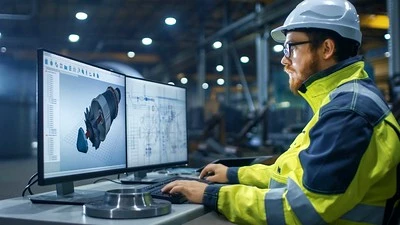Where Can You Take Osha-Compliant Scissor Lift Training?
July 23, 2024 | by Mike Pattenson


You can take OSHA-compliant scissor lift training at vocational trade schools, specialized training centers, and through employer-sponsored training programs. Here’s a breakdown of each:
1. Vocational Trade Schools:
Vocational trade schools are educational institutions that offer specialized training programs focused on specific trades and skills. In these schools, you can enroll in training courses that cover both theoretical knowledge and practical skills. The courses are designed to teach you the safety regulations, operating procedures, and maintenance requirements for scissor lifts.
You’ll spend time in the classroom learning about OSHA standards and other safety protocols, and you’ll also get hands-on experience operating the equipment under the supervision of experienced instructors.
2. Specialized Training Centers:
Specialized training centers are facilities dedicated to providing instruction on the use of various industrial equipment, including scissor lifts. These centers often have the latest models of scissor lifts and other machinery, ensuring you get up-to-date training. The instructors at these centers are usually experts with extensive field experience.
The programs are comprehensive, covering everything from basic operations to advanced techniques and safety measures. These centers are ideal if you want focused, intensive training in a professional environment.
3. Employer-Sponsored Training:
Many companies offer employer-sponsored training programs for their employees. In these programs, employers bring certified trainers to the job site to conduct the training.
This type of training is highly practical because it takes place in the actual work environment, allowing you to learn how to operate the scissor lift in the context of your specific job duties.
Employer-sponsored training ensures that all employees are trained according to OSHA standards and company-specific safety protocols. It’s convenient and tailored to the specific needs of the workplace, making it a popular option for many businesses.
You Can Take The Scissor Lift Training Online
You can also take OSHA-compliant training online. Online programs are convenient and flexible, allowing you to learn at your own pace from anywhere with internet access. These programs typically include video tutorials, interactive modules, and quizzes to help you understand the safety rules and operational procedures.
Online courses cover essential topics like hazard recognition, safe operation practices, and OSHA regulations.
However, it’s important to note that while the theoretical part of the training can be completed online, you’ll still need to arrange hands-on practice with a certified trainer to fully comply with OSHA standards.
Online scissor lift training provides a convenient and flexible way to learn how to safely operate a scissor lift while meeting OSHA compliance requirements. Here’s a detailed explanation:
- Convenience and Flexibility:
- Self-Paced Learning: You can complete the training at your own pace, which is particularly useful if you have a busy schedule. You can log in and study whenever it’s convenient for you, whether that’s during breaks at work, in the evenings, or on weekends.
- Accessibility: Online training can be accessed from anywhere with an internet connection, eliminating the need to travel to a training center.
- Comprehensive Curriculum:
- Video Tutorials: These provide visual demonstrations of proper operation, safety procedures, and common hazards. Seeing these actions performed can enhance your understanding and retention of the material.
- Interactive Modules: These may include simulations and interactive exercises that allow you to engage with the material in a hands-on way, reinforcing your learning.
- Quizzes and Assessments: Regular quizzes and final assessments help ensure you understand the key concepts and can apply them in real-world scenarios.
- Essential Topics Covered:
- Hazard Recognition: Learn to identify potential hazards when operating the equipment, such as uneven surfaces, overhead obstacles, and electrical hazards.
- Safe Operation Practices: Instruction on the correct way to operate the lift, including how to perform pre-operation inspections, how to properly position the lift, and how to safely raise and lower the platform.
- OSHA Regulations: Detailed coverage of OSHA standards related to scissor lifts, ensuring you understand the legal requirements and best practices for safety.
- Hands-On Practice:
- Practical Component: While the theoretical part can be completed online, OSHA requires hands-on practice to fully comply with the standards. This means you’ll need to arrange for practical training with a certified instructor or through an approved training facility.
- Certification: After completing both the online theoretical training and the hands-on practical component, you will receive a certification that confirms you have met the OSHA requirements.
- Choosing a Program:
- Accreditation: Ensure the online training program is accredited and recognized by OSHA or other relevant authorities.
- Support: Look for programs that offer support, such as access to instructors for questions or additional resources for further learning.
Online training is an effective way to gain the necessary knowledge and skills to operate the equipment safely and in compliance with OSHA standards, combining the flexibility of online learning with the essential hands-on experience required for certification.
Types of Training Providers
In-Person
- Advantages:
- Hands-on Experience: You get to work directly with the scissor lift, which helps you understand its operation better.
- Direct Instructor Feedback: Instructors can give you immediate feedback and correct any mistakes on the spot, ensuring you learn the correct techniques.
- Limitations:
- Scheduling: These programs often have fixed schedules, which might not fit into your personal or work commitments.
- Location Constraints: You may need to travel to a specific training facility, which could be inconvenient or far from your home or workplace.
Online
- Advantages:
- Flexibility: You can complete the training at your own pace and at times that suit you, making it easier to fit into a busy schedule.
- Convenience: You can take the training from anywhere with an internet connection, eliminating the need to travel.
- Cost-Effectiveness: Online programs are often cheaper than in-person training because they don’t require physical facilities or as many instructors.
- Limitations:
- Lack of Hands-on Practice: These programs usually don’t provide the opportunity to physically operate a scissor lift, which is crucial for gaining practical experience.
Hybrid
- Description: These programs combine the best of both worlds by offering online theoretical training followed by in-person practical sessions.
- Benefits:
- Flexibility: You can complete the theoretical part online at your own pace, making it easier to manage your time.
- Practical Experience: You still get to practice operating a scissor lift in person, ensuring you gain the necessary hands-on skills.
- Comprehensive Learning: This approach ensures you understand both the theory and the practical aspects of scissor lift operation, leading to a more well-rounded training experience.
Tips for Choosing the Right Training Providers
Factors to Consider When Selecting a Training Provider
1. Accreditation and Reputation
- Accreditation:
- OSHA Compliance: Ensure the provider is accredited by OSHA or similar regulatory bodies such as CSA.
- Certifying Bodies: Other recognized certifying organizations might include ANSI or IACET.
- Reputation:
- Industry Standing: Check if the provider is well-regarded in the industry. This can be measured by their affiliations with professional organizations like the National Safety Council (NSC) or the Scaffold & Access Industry Association (SAIA).
- Years in Business: Providers with 10+ years of experience generally have a proven track record.
- Success Rate: Look for providers that have a high certification success rate, ideally over 90%.
2. Training Content and Curriculum
- Comprehensive Coverage:
- Safety Procedures: Training should include modules on OSHA 1926 Subpart L (Scaffolds) and ANSI A92 standards, covering emergency descent, fall protection, and hazard recognition.
- Equipment Operation: Courses should detail operational procedures, such as pre-operation inspections, safe maneuvering techniques, and emergency shutdown procedures.
- Maintenance Protocols: Ensure the curriculum includes maintenance checks according to the manufacturer’s recommendations and OSHA guidelines.
- Up-to-Date Information:
- Latest Regulations: The training should reflect the most recent updates to OSHA and ANSI standards, ensuring compliance with current laws.
- Technological Advances: Include training on modern features like load sensing and tilt sensors.
3. Cost and Duration
- Affordability:
- Price Range: The costs can vary widely. In-person might range from $200 to $500, while online courses might be more affordable, typically between $59 and $150.
- Included Materials: Check if the cost covers all training materials, certification fees, and any necessary personal protective equipment (PPE).
- Time Commitment:
- Course Length: In-person often lasts 1-2 days (8-16 hours), while online courses can be completed at your own pace, usually within 4-8 hours.
- Certification Validity: Ensure the certification is valid for at least 3-5 years, as per industry standards.
4. Availability of Practical Hands-On Training
- Hands-On Experience:
- Practical Sessions: Verify that the program includes at least 4-8 hours of practical, hands-on training with a scissor lift.
- Equipment Variety: Training should cover different types of scissor lifts, including electric and rough terrain models.
- Real-World Scenarios:
- Simulations: The program should include practical exercises that mimic real-world job site conditions, such as navigating tight spaces and operating at maximum lift height (typically 20-50 feet, depending on the equipment model).
5. Importance of Checking Reviews and Testimonials
- Customer Feedback:
- Ratings: Look for providers with high ratings (4+ stars) on review platforms like Google Reviews, Yelp, or industry-specific forums.
- Detailed Reviews: Read detailed reviews that mention the effectiveness of the training, the quality of instructors, and the comprehensiveness of the content.
- Success Stories:
- Testimonials: Pay attention to testimonials that highlight specific benefits, such as improved safety records, increased job performance, and enhanced career opportunities.
- Case Studies: Some providers may offer case studies showing the impact of their training on various companies, including metrics like reduced accident rates or compliance improvement.
By considering these detailed factors and technical aspects, you can choose a training provider that not only meets regulatory requirements but also equips you with the necessary skills and knowledge for safe and efficient equipment operation.
To Make a Conclusion
Choosing the right place to take OSHA-compliant scissor lift training is crucial for your safety and career. Whether you prefer in-person, online, or hybrid training, make sure the provider is accredited and has a good reputation.
Look for comprehensive and up-to-date courses that fit your budget and schedule, and always check if they offer hands-on practice.
Reading reviews and testimonials can also help you find a reliable program. By considering these factors, you can ensure you get the best training to operate scissor lifts safely and effectively.
RELATED POSTS
View all



